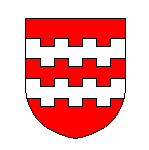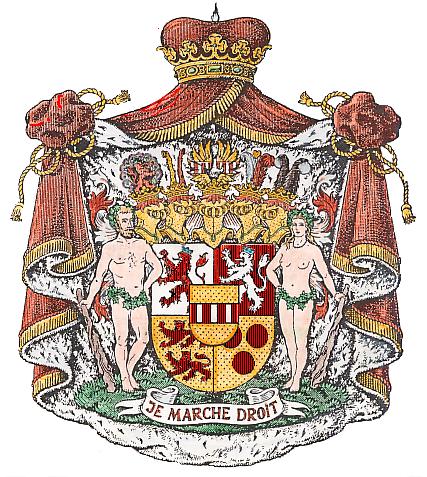|
Adolf II Of Berg
Adolf II of Berg-Hövel (Huvili), count of Berg, count in Auelgau and Siegburg, Vogt of Werden (died 1090/1106), was the son of Adolf I of Berg. He married Adelaide of Lauffen, a daughter of Heinrich II count von Laufen (died 1067) and Ida von Werl-Hövel (1030? – 1090), and heiress of Hövel/Huvili, Unna, Telgte, Warendorf, etc. At the beginning of the 12th century Adolf II of Berg donated the site of their old ancestral castle, Schloss Berg, to Cistercian monks from Burgundy. Adolf IV later built the Altenberg Abbey. He had issue: * Adolf III of Berg count of Berg Berg may refer to: People *Berg (surname), a surname (including a list of people with the name) *Berg Ng (born 1960), Hong Kong actor * Berg (footballer) (born 1989), Brazilian footballer Former states *Berg (state), county and duchy of the Holy ... and Hövel, Vogt of Werden (born 1080, died 12 Oct 1152). Literature * Alberic of Troisfontaines (MGH, Scriptores XXIII). * Annales Rodenses (MGH, Scriptores, XVI) ... [...More Info...] [...Related Items...] OR: [Wikipedia] [Google] [Baidu] |
Altenberg Abbey
Altenberg Abbey (''Abtei Altenberg'') ( la, Vetus Mons) is a former Cistercian monastery in Altenberg, now a part of the municipality of Odenthal in the Bergisches Land, North Rhine-Westphalia, Germany. History The abbey was founded in 1133 as a daughter house of Morimond Abbey and settled initially in the old castle of the Counts of Berg, Burg Berge, which the counts had left for Schloss Burg, but moved to the new purpose-built monastery in the valley of the Dhünn in 1153.Norbert Orthen: ''Unter dem Zeichen der Jakobsmuschel. Altenberg – eine Station auf dem Jakobusweg.''online) It flourished sufficiently to undertake the settlement of a number of daughter houses of its own: Mariental Abbey and Wągrowiec Abbey, both in 1143; Ląd Abbey in 1146; Zinna Abbey in 1171; Haina Abbey in 1188; Jüterbog Abbey in 1282; and Derneburg Abbey in 1443. In 1803 it was dissolved during the secularisation of Germany and fell into ruin. Starting in 1847 under King Frederick William IV ... [...More Info...] [...Related Items...] OR: [Wikipedia] [Google] [Baidu] |
Count Of Berg
Berg was a state—originally a county, later a duchy—in the Rhineland of Germany. Its capital was Düsseldorf. It existed as a distinct political entity from the early 12th to the 19th centuries. The name of the county lives on in the modern geographic term Bergisches Land, often misunderstood as ''bergiges Land'' (hilly country). History Ascent The Counts of Berg emerged in 1101 as a junior line of the dynasty of the Ezzonen, which traced its roots back to the 9th-century Kingdom of Lotharingia, and in the 11th century became the most powerful dynasty in the region of the lower Rhine. In 1160, the territory split into two portions, one of them later becoming the County of the Mark, which returned to the possession of the family line in the 16th century. The most powerful of the early rulers of Berg, Engelbert II of Berg died in an assassination on November 7, 1225. In 1280 the counts moved their court from Schloss Burg on the Wupper river to the town of Düsseldorf. Cou ... [...More Info...] [...Related Items...] OR: [Wikipedia] [Google] [Baidu] |
Adolf I Of Berg
Adolf I of Berg, count of Berg from 1077 until 1082, Vogt of Werden, Deutz, Berg and Gerresheim (died 1086). He was the son of Adolf II of Lotharingia count of Keldachgau, Vogt of Deutz (1002–1041). The dynasty can be traced back to Adolf I at the beginning of the eleventh century especially by following the succession of the advocates of Deutz monastery across the Rhine, opposite Cologne. From that point forth the succession of the counts of Berg is well enough documented. Adolf I of Berg left one son: * Adolf II of Berg-Hövel, count of Berg, count of Auelgau and Siegburg, Vogt of Werden, founded the Altenberg Abbey (died 1090 or 1106). Literature * Alberic of Troisfontaines (MGH, Scriptores XXIII). * The ''Annales Rodenses'' from the Dutch medieval abbey at Rolduc, (MGH, Scriptores, XVI). * Annalista Saxo The Annalista Saxo ("Saxon annalist") is the anonymous author of an important imperial chronicle, believed to have originated in the mid-12th century at Nienburg Abb ... [...More Info...] [...Related Items...] OR: [Wikipedia] [Google] [Baidu] |
Adolf III Of Berg
Adolf III of Berg (1080 – 12 October 1152) was count of Berg from 1093 until 1132, and count of Hövel from 1090 until 1106, and Vogt of Werden. He was the son of Adolf II of Berg-Hövel, count of Berg, and Adelaide of Lauffen. He married Adelheid of Cleves (von Kleve), possibly a daughter of Dietrich II count of Cleves (died 1118). They had issue: * Adolf IV of Berg count of Berg and count of Altena (died after 1161); * Eberhard of Berg, monk in Morimont, 1st Abbot of Georgenthal (1143–1152) in Thüringen (born 1090/95, died 1152, buried in Altenberg (Gedenktag katholisch: 22. Juli - "Er bewog seinen Bruder, dem Orden 1133 auch das von der Familie gestiftete Kloster in Altenberg zu übertragen. Eberhard wurde dann 1143 Abt in dem von seinem Schwager gestifteten Kloster Georgenthal bei Gotha"); * Bruno II of Berg, Archbishop of Cologne between 1131 and 1137 (died in Trani, Italy 30 May 1137, buried in Bari); * Gisela of Berg Berg may refer to: People *Berg (surname), a ... [...More Info...] [...Related Items...] OR: [Wikipedia] [Google] [Baidu] |
Berg (state)
Berg was a state—originally a county, later a duchy—in the Rhineland of Germany. Its capital was Düsseldorf. It existed as a distinct political entity from the early 12th to the 19th centuries. The name of the county lives on in the modern geographic term Bergisches Land, often misunderstood as ''bergiges Land'' (hilly country). History Ascent The Counts of Berg emerged in 1101 as a junior line of the dynasty of the Ezzonen, which traced its roots back to the 9th-century Kingdom of Lotharingia, and in the 11th century became the most powerful dynasty in the region of the lower Rhine. In 1160, the territory split into two portions, one of them later becoming the County of the Mark, which returned to the possession of the family line in the 16th century. The most powerful of the early rulers of Berg, Engelbert II of Berg died in an assassination on November 7, 1225. In 1280 the counts moved their court from Schloss Burg on the Wupper river to the town of Düsseldorf. Coun ... [...More Info...] [...Related Items...] OR: [Wikipedia] [Google] [Baidu] |
Adelaide Of Lauffen
Adelaide of Lauffen (also ''Adelheid von Lauffen''; – after 1130) was a German noblewoman. Family Background Adelaide was the daughter of Count Henry II of Lauffen (d.1067) and his wife, Ida of Hövel (1030?-1090), daughter of Bernard I, count of Werl and Hövel. From her parents, Adelaide inherited Hövel, Unna, Telgte und Warendorf. Marriages and Children Adelaide was married twice. Around 1090, Adelaide married, as her first husband, Adolf II of Berg. With Adolf Adelaide had three sons: *Adolf III of Berg * Bruno of Berg, later archbishop of Cologne (r.1131-1137) *Everhard/Eberhard, later abbot of the monastery of Georgenthal After Adolf's death in 1106, Adelaide married Frederick I/V, count of Sommerschenburg, and count palatine of Saxony (r. 1111–1120). With Frederick, Adelaide had two children: *Frederick II/VI of Sommerschenburg, count palatine of Saxony (d.1162), who married his niece, Lutgard of Salzwedel *Adelaide, who married Goswin II of Heinsberg He ... [...More Info...] [...Related Items...] OR: [Wikipedia] [Google] [Baidu] |
Counts Of Berg
Berg was a state—originally a county, later a duchy—in the Rhineland of Germany. Its capital was Düsseldorf. It existed as a distinct political entity from the early 12th to the 19th centuries. The name of the county lives on in the modern geographic term Bergisches Land, often misunderstood as ''bergiges Land'' (hilly country). History Ascent The Counts of Berg emerged in 1101 as a junior line of the dynasty of the Ezzonen, which traced its roots back to the 9th-century Kingdom of Lotharingia, and in the 11th century became the most powerful dynasty in the region of the lower Rhine. In 1160, the territory split into two portions, one of them later becoming the County of the Mark, which returned to the possession of the family line in the 16th century. The most powerful of the early rulers of Berg, Engelbert II of Berg died in an assassination on November 7, 1225. In 1280 the counts moved their court from Schloss Burg on the Wupper river to the town of Düsseldorf. Coun ... [...More Info...] [...Related Items...] OR: [Wikipedia] [Google] [Baidu] |
House Of Berg
A house is a single-unit residential building. It may range in complexity from a rudimentary hut to a complex structure of wood, masonry, concrete or other material, outfitted with plumbing, electrical, and heating, ventilation, and air conditioning systems.Schoenauer, Norbert (2000). ''6,000 Years of Housing'' (rev. ed.) (New York: W.W. Norton & Company). Houses use a range of different roofing systems to keep precipitation such as rain from getting into the dwelling space. Houses may have doors or locks to secure the dwelling space and protect its inhabitants and contents from burglars or other trespassers. Most conventional modern houses in Western cultures will contain one or more bedrooms and bathrooms, a kitchen or cooking area, and a living room. A house may have a separate dining room, or the eating area may be integrated into another room. Some large houses in North America have a recreation room. In traditional agriculture-oriented societies, domestic animals such as ... [...More Info...] [...Related Items...] OR: [Wikipedia] [Google] [Baidu] |
Counts Of Limburg
Count (feminine: countess) is a historical title of nobility in certain European countries, varying in relative status, generally of middling rank in the hierarchy of nobility. Pine, L. G. ''Titles: How the King Became His Majesty''. New York: Barnes & Noble, 1992. p. 73. . The etymologically related English term "county" denoted the territories associated with the countship. Definition The word ''count'' came into English from the French ''comte'', itself from Latin ''comes''—in its accusative ''comitem''—meaning “companion”, and later “companion of the emperor, delegate of the emperor”. The adjective form of the word is "comital". The British and Irish equivalent is an earl (whose wife is a "countess", for lack of an English term). In the late Roman Empire, the Latin title ''comes'' denoted the high rank of various courtiers and provincial officials, either military or administrative: before Anthemius became emperor in the West in 467, he was a military ''comes ... [...More Info...] [...Related Items...] OR: [Wikipedia] [Google] [Baidu] |
House Of Limburg-Stirum
The House of Limburg-Stirum (or Limburg-Styrum), which adopted its name in the 12th century from the immediate county of Limburg an der Lenne in what is now Germany, is one of the oldest families in Europe. It is the eldest and only surviving branch of the House of Berg, which was among the most powerful dynasties in the region of the lower Rhine during the Middle Ages. Some historians link them to an even older dynasty, the Ezzonen, going back to the 9th century. The Limburg-Stirum were imperial counts within the Holy Roman Empire, until they were mediatised in 1806 by the Confederation of the Rhine. Although undisputedly a mediatised comital family, having enjoyed a dynastic status for over 600 years until the collapse of the Empire, they were omitted from the ''Almanach de Gotha'' because the branches of the family possessing mediatised lands were extinct by the time (1815) that the Congress of Vienna established the German Confederation's obligation to recognise their dynas ... [...More Info...] [...Related Items...] OR: [Wikipedia] [Google] [Baidu] |
11th-century Births
The 11th century is the period from 1001 ( MI) through 1100 ( MC) in accordance with the Julian calendar, and the 1st century of the 2nd millennium. In the history of Europe, this period is considered the early part of the High Middle Ages. There was, after a brief ascendancy, a sudden decline of Byzantine power and a rise of Norman domination over much of Europe, along with the prominent role in Europe of notably influential popes. Christendom experienced a formal schism in this century which had been developing over previous centuries between the Latin West and Byzantine East, causing a split in its two largest denominations to this day: Roman Catholicism and Eastern Orthodoxy. In Song dynasty China and the classical Islamic world, this century marked the high point for both classical Chinese civilization, science and technology, and classical Islamic science, philosophy, technology and literature. Rival political factions at the Song dynasty court created strife amongst ... [...More Info...] [...Related Items...] OR: [Wikipedia] [Google] [Baidu] |
1090 Deaths
1 (one, unit, unity) is a number representing a single or the only entity. 1 is also a numerical digit and represents a single unit of counting or measurement. For example, a line segment of ''unit length'' is a line segment of length 1. In conventions of sign where zero is considered neither positive nor negative, 1 is the first and smallest positive integer. It is also sometimes considered the first of the infinite sequence of natural numbers, followed by 2, although by other definitions 1 is the second natural number, following 0. The fundamental mathematical property of 1 is to be a multiplicative identity, meaning that any number multiplied by 1 equals the same number. Most if not all properties of 1 can be deduced from this. In advanced mathematics, a multiplicative identity is often denoted 1, even if it is not a number. 1 is by convention not considered a prime number; this was not universally accepted until the mid-20th century. Additionally, 1 is the ... [...More Info...] [...Related Items...] OR: [Wikipedia] [Google] [Baidu] |





